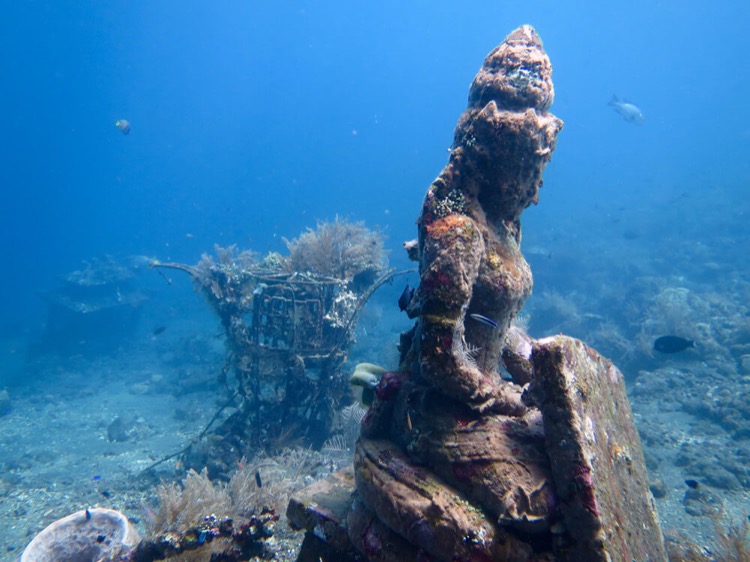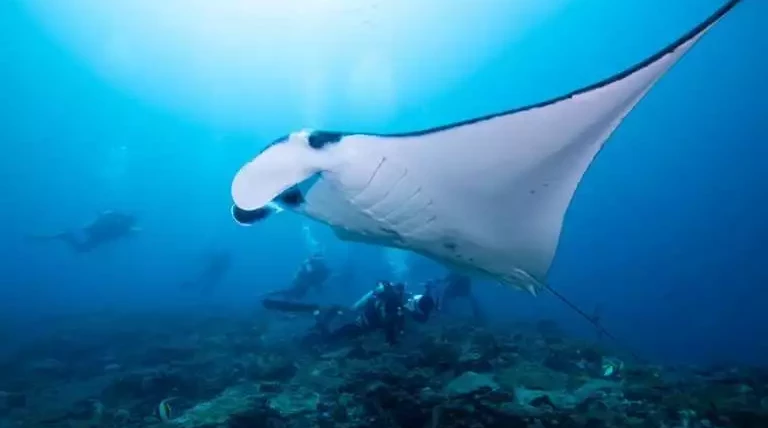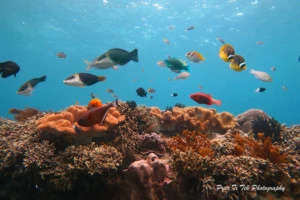DIVING SITES: TULAMBEN
Here in Tulamben, the sea is generally calm, which provides easier and more relaxing snorkeling and dives sessions in Tulamben. This place is world-renowned amongst divers, and is particularly famous for the USAT Liberty wreck.
We recommend Tulamben diving as your first dive experience in Bali: the spot is ideal to discover the marine life.
From Dune Bali’s main office in Sanur (Denpasar), you will travel by minibus to the north eastern corner of Bali (about 2h20), to the tiny fishing village of Tulamben; one of the most renowned and most frequented locations in Bali for scuba diving. For this dive in Tulamben, You will have the opportunity to observe a multitude of species of fish and corals known to inhabit the seas of Indonesia.
The rich biodiversity of the sea floor attracts underwater photographers, naturalists, and divers passionated about marine biology. Dive in Tulamben is recommended for both macro lovers and ambiance photographers, as the colorful marine life stands out against the volcanic black sand sea bed.

Tulamben Dive Site
The Liberty wreck is one of the most easily dived wrecks in the world. Located just 25 metres from shore, and resting between 5 – 30 metres deep, it is accessible to all levels and variety of divers: introduction (1st time) divers, beginners, experienced, freedivers, and snorkelers can all enjoy this enchanting wreck.
In 1942, the USAT Liberty, a United States military cargo ship, was torpedoed by the Japanese while stationing off the strait of Lombok. Damaged, the Unites States towed the ship towards Bali, hoping to make it to the northern region of Singaraja, but the ship began to break apart and instead was beached onto the shore of Tulamben.
In 1963, the earthquakes caused by the volcanic eruption of Mount Agung pushed the ship into the sea where it sank onto its side and was forgotten until the early 1980’s. During the last 50 years it remained underwater, and a marine life of all colors, shapes, and sizes have colonized the 120 metre- long vessel. Night dives are also unforgettable! Each night the numerous Parrot fish arrives on the wreck and sleep there together as one big family (there are about 20 individuals).
THE HISTORY OF THE LIBERTY SHIP
The USAT Liberty, the first ship built by the Federal Shipbuilding of New Jersey, was a United States Army cargo ship.
WORLD WAR I
The Liberty was launched by Federal Shipbuilding Kearny, New Jersey, on 19 June 1918. The ship was acquired by the United States Navy on 7 October 1918 and commissioned on the same day as the United States shipping board in World War I. Its first assignment was to transport horses from New York on 24 October 1918 and arrive in France on 8 November 1918. Over the next six months, this ship made two additional voyages carrying general cargo and live animals. Its last assignment before decommissioning was to transport 436 tonnes of United States Army cargo and 2,072 tonnes of steel rails. This ship arrived in Virginia after its final voyage on 30 April 1919. This ship was officially decommissioned on 7 May 1919 and returned to the United States Shipping Board on the same day.
BETWEEN WORLD WAR I AND WORLD WAR II
The Liberty, decommissioned on 7 May 1919, was still sailing before being used in World War II. But unfortunately, this ship had collided two times with other boats. First, this ship collided with the French tug Dogue in the Seine-Maritime, France, on 20 October 1929, which caused the Dogue to sink and lose two crew members. The second time, this ship collided with the American cargo ship Ohioan in Ambrose Channel, New York, on 23 November 23, 1933, which caused the Ohioan ship to be stranded near West Bank Light. After these two collisions, the Liberty was still able to survive.
WORLD WAR II
At the start of World War II, in 1939, the Liberty, still owned by the United States Maritime Commission, was employed by the Southgate-Nelson Corporation of Norfolk, Virginia, the operator of several packet lines. Later in November 1940, this ship was taken over by the United States Army for defense service. This ship was armed with two cannons, a large caliber at the bow and a small caliber at the stern. Initially, when the United States entered World War II in December 1941, this ship served in the Pacific. But unfortunately, on 11 January 1942, this ship, on its way from Australia to the Philippines with railway parts and rubber, was hit by two torpedoes from the Japanese submarine I-66 about ten nautical miles (19 km) southwest of the Lombok Strait, near the position 08°54′S 115°28′E. Fortunately, this ship that two torpedoes had hit managed to survive and not sink.
The US destroyer Paul Jones and the Dutch destroyer Van Ghent attempted to take the damaged Liberty to Celukan Bawang Harbor in Singaraja, a Dutch port and administrative center for the Lesser Sunda Islands, on the northern coast of Bali. But again, unfortunately, this ship had swallowed a lot of water, so it was stranded on the east coast of Bali in Tulamben. At least the cargo and equipment could be saved.
THE SINK OF THE LIBERTY
The Liberty was stranded on the east coast of Bali for a long time. Later, due to the eruption of Mount Agung in 1963, this ship slipped 25 meters from the beach and was at a depth of 5-30 meters. In that depth, this ship that has become a wreck still has charm.
ADVANTAGES AND UNIQUENESS
The Liberty Wreck is located not far from the coast, about 25 meters, and has a depth of 5-30 meters, making it one of the easiest to dive shipwrecks in the world. Also, the water current is not too heavy, making it easier for divers to move into the wreck. However, this wreck’s uniqueness lies in the impact that it has been overgrown with various colorful corals and sea animals living among the ruins.
MARINE BIOTA
The Liberty Wreck was stranded on the east coast of Bali in Tulamben for a long time. During that time, this ship started to rust, and the paint made to avoid the formation of life sprang to fade little by little from the steel plates so that this wreck began to be overgrown by various corals such as gorgonians of multiple colors. Divers can also find humphead parrotfish, jackfish, groupers, and many other species.
THREAT
Amid the increasing number of irresponsible divers who visit and touch the Liberty Wreck, the condition of this wreck is getting worse. This reckless driving behavior is something that Dune Bali has consistently campaigned against: do not touch the corals, the fishes, and their homes. We are in the water to experience the underwater world’s beauty, not ruin it.
FRAGILITY
The wreck of the Liberty is getting old, plus natural factors such as big waves threaten the sustainability of this wreck. It doesn’t stop there. During the high season for divers, dozens of people can be on this wreck simultaneously, which threatens the sustainability even more. This wreck is now experiencing decay; many parts of the ship have fallen, and parts of the boat are buried by rocks or sand.
PRESERVATION
If the Liberty Wreck is destroyed, it will impact the loss of marine life, which is the main attraction of Tulamben tourist destination. This hurts the people of Tulamben, whose source of income is usually dependent on the tourism sector. Therefore, local dive guides and the village government discussed various plans to protect this wreck. Ensuring the zoning of conservation and preservation of this wreck site and installing signs for divers is a plan to preserve this wreck.
CORAL GARDEN
From the beach, just south of the wreck, macro-life and photography enthusiasts will be delighted ! The flora and fauna here is very rich and also abundant, even in the shallows (4-10m).
A number of artificial reef structures attract a large quantity of fishes, including species such as damselfish, butterfly fish, and surgeonfish, and also important numbers of “cleaning stations” where morays, groupers, snappers and other species come to partake in a symbiotic relationship with the shrimps that “clean off” or eat the parasites living on their bodies. This is an ideal location for a night dive.
THE DROP OFF OF TULAMBEN
The large wall of Tulamben, fittingly called Drop Off, is one of the most popular dive sites in Bali. The reef descends from 3 metres down to 70 metres deep; the sheer wall was created by the lava flow from the eruption of Mount Agung in 1963.
This wall is covered by a great number of corals, gorgonians, and sponges. The topography of the site is incredible thanks to its sheer underwater cliffs, where you can encounter “cleaning stations”,as well as a multitude of enormous, vibrantly colored sponges and gorgonians. The dive continues to an undulating plateau of coral where you can find morays, mantis shrimp, and varieties of pipefish hiding in the crevices.
BATU KELEBIT
Access this dive site within a quick 10 minutes ride in a jukung (traditional boat). BatuKelebit is quite different from the other sites of that shore as the sea floor is made up of white sand, and the corals, beautiful as always, descend to over 60 metres deep. This dive site is ideal for a deep dive.
The average depth of the dive is usually around 25 metres. The site itself is composed of a sloping coral reef, beginning from a very small bay that is exposed to the mild current, making it rich in plankton and therefore a good place to see pelagics, such as rays, tunas, barracudas, and white and black tip reef sharks.
SERAYA SECRET
Seraya is a particularly great site for “muck diving”. It’s a paradise for macro-life, and therefore more recommended to photographers and divers who love the tiniest of creatures. Here we can find strange and rare creatures, such as the famous harlequin shrimp, ghost pipefish, mimic octopus, nudibranch, frogfish, dragonets, and a myriad of cleaning stations where you’ll find morays and a diverse array of colorful fish.
KUBU
North of Tulamben, Kubu is a tiny village. Just out from the beach, and positioned upright on the sloping sandy bottom, you can find a wreck measuring 85 metres in length and asleep between 13 – 30 metres deep.
The ship is still completely intact, and decorated with many interesting features such as Buddhist statues, a war-era Volkswagen convertible car, glass bottles, ceramic pottery, and more. With an interesting ambiance, black sand, and a coral garden just in the shallows, this is an intriguing dive with very few divers exploring it!
KUBU REEF:
KUBU WRECK:
ALAMANDA
Alamanda, situated in Tulamben Bay, is a few-visited dive site. The place can be reached by Jukung (traditional boats). As one of the most awesome Tulamben diving, Alamanda has plenty to offer including its stunning and rich underwater. To enhance your diving there, Dune crews will guide divers with their professional assistance.
Thanks to its particular topography, the place is well protected from the current. However, the spot is really deep and mostly recommended to experienced divers.
Alamanda, which the name comes from a sort of exotic flower, is an outstanding diving site, when all conditions have been met: Actually there is an amazing contrast between the white sand and the coral reefs. In that particular spot, you can find a myriad of giant gorgones, hard and soft corals, and so many other species from the submarine fauna and flora: it makes the site be a heavenly place for divers. You can also meet many pelagics there.








